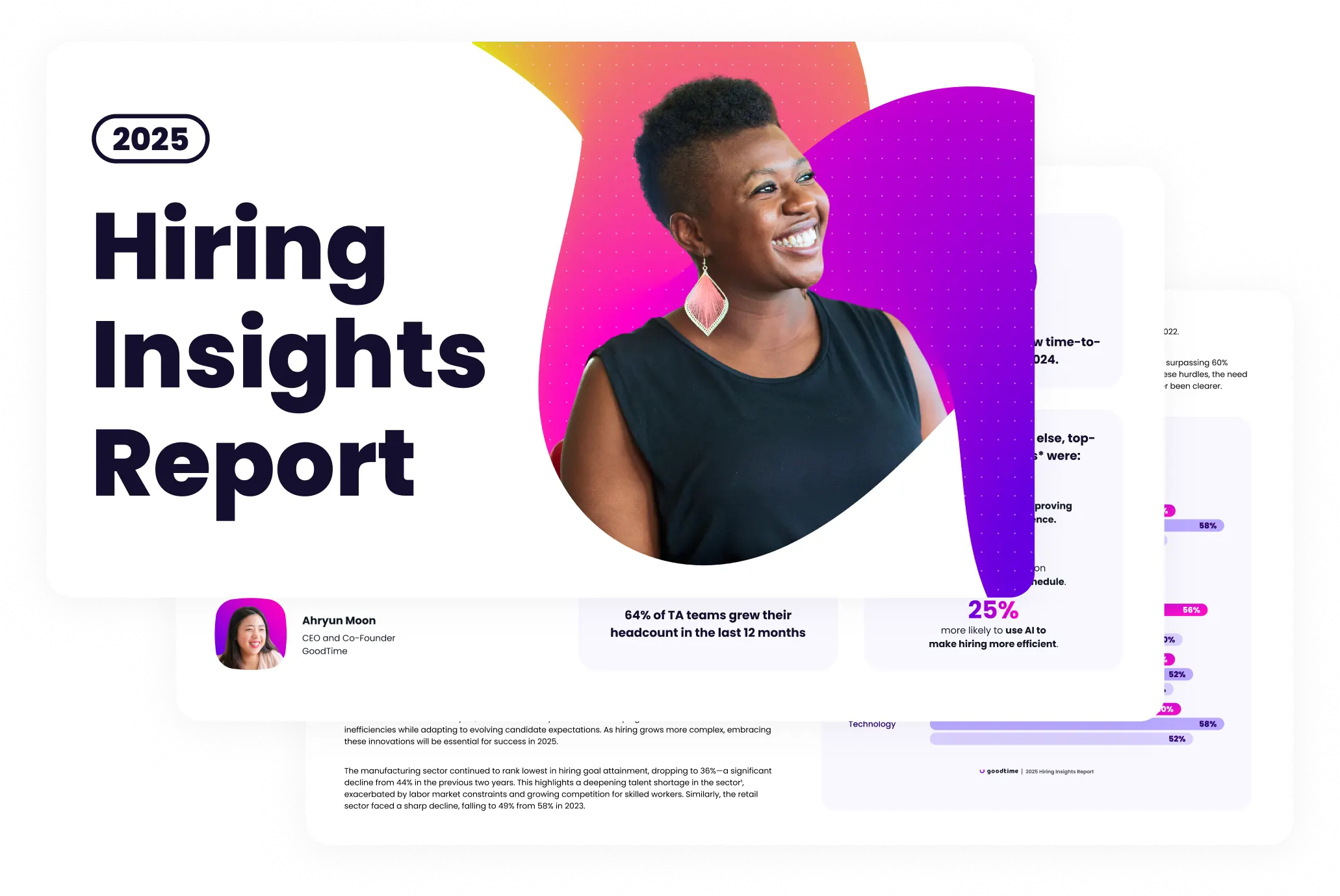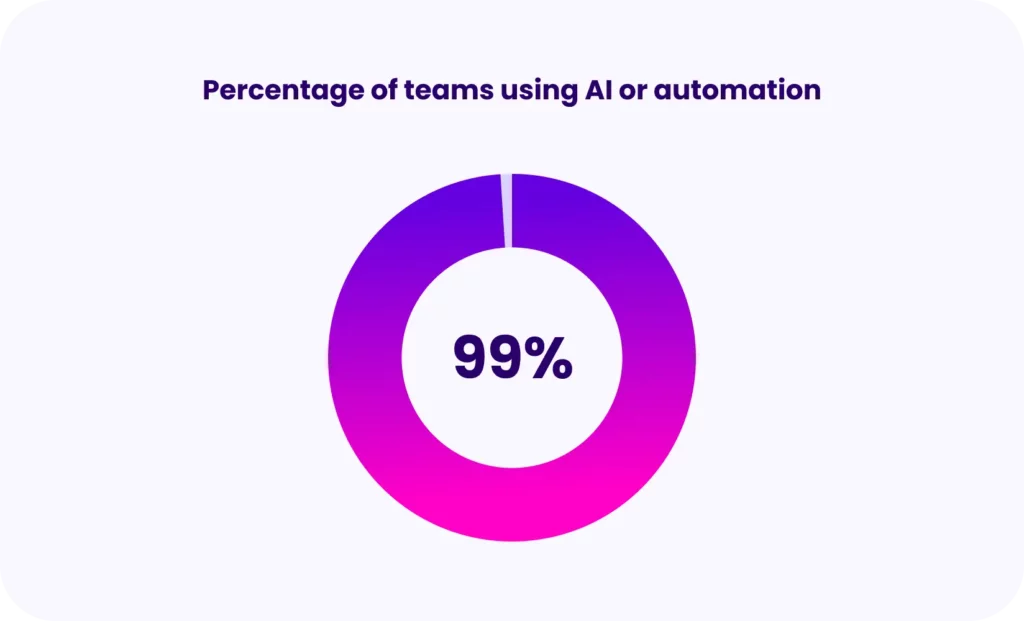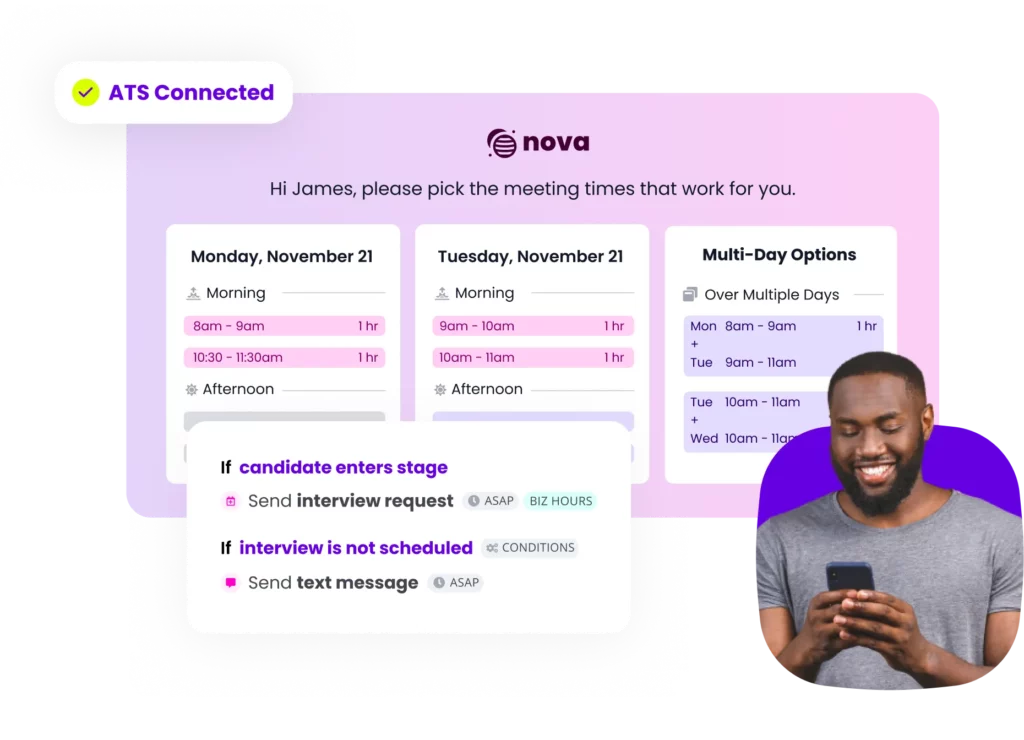Table of Contents
In the world of hiring, the terms “talent acquisition” and “recruitment” are often used interchangeably, but they actually represent two distinct approaches to filling roles within a company. As organizations strive to navigate the competitive job market, understanding the nuances between these two functions is crucial. While recruitment focuses on the immediate need to fill positions, talent acquisition takes a broader, more strategic approach, ensuring the long-term success of the organization by building a robust talent pipeline.
In this article, we’ll explore the key differences between talent acquisition and recruitment, drawing on expert insights to provide a comprehensive understanding of when and how to use each strategy effectively. You’ll hear from industry leaders like Charles Mah, Chief Customer and Operations Officer of GoodTime, and Geva Whyte, a seasoned Recruiting Coordinator with experience at Lyft, OpenAI, and Stripe, who offer their perspectives on these critical functions.
Defining talent acquisition and recruitment
Before diving into the differences between talent acquisition and recruitment, it’s essential to define what each term means within the context of hiring.
Recruitment
Recruitment is often seen as the more immediate and tactical side of hiring. It’s a process that kicks in when there is a specific job opening that needs to be filled. The focus is on quickly sourcing, interviewing, and hiring candidates to meet the organization’s current needs. Activities in recruitment typically include:
- Crafting job descriptions
- Posting job openings on various platforms
- Sourcing candidates through job boards, social media, and networking
- Screening resumes and conducting interviews
- Extending job offers to successful candidates
The goal of recruitment is to efficiently fill a vacancy with the best available candidate. It’s often a reactive process, driven by immediate needs within the company, such as filling a position that has become vacant or expanding the team to meet a new business requirement.
Talent acquisition
On the other hand, talent acquisition takes a broader and more strategic approach. Rather than focusing solely on filling immediate vacancies, talent acquisition is about building and nurturing a pipeline of qualified candidates who can meet the organization’s future needs. This process involves:
- Strategic workforce planning and recruiter capacity planning
- Employer branding and candidate experience management
- Building long-term relationships with potential candidates
- Using data and analytics to guide hiring decisions
- Continuously improving recruitment processes to attract top talent
Talent acquisition is a proactive and ongoing effort, aiming to align the company’s long-term goals with its talent strategy. It requires a deep understanding of the industry, the competitive landscape, and the evolving needs of the business.
As Charles Mah, Chief Customer and Operations Officer of GoodTime, aptly puts it: “Talent Acquisition is akin to customer success. It’s about ensuring the business grows by hiring the right talent and providing the best experience to retain every candidate they engage with because they are likely future hires or customers.”

Unlock 2025’s top hiring strategies: Insights from 500+ TA leaders
Be the first to uncover deep hiring insights specific to your sector — straight from the highest-performing TA teams.

Key differences between talent acquisition and recruitment
While both talent acquisition and recruitment aim to bring new employees into an organization, their approaches, goals, and outcomes differ significantly. Understanding these differences can help companies decide when to use each strategy and how to align them with their overall business objectives.
Focus and goals
- Recruitment is primarily focused on filling open positions as quickly as possible. The goal is to find a qualified candidate who can step into the role and start contributing immediately. This makes recruitment more of a short-term, task-oriented process driven by the immediate needs of the organization.
- Talent acquisition, on the other hand, is focused on long-term strategic goals. It involves not only filling current positions but also anticipating future needs and building a pipeline of candidates who are well-suited to the company’s culture and long-term objectives. This approach helps the organization maintain a steady flow of talent, ready to step in as the company grows or as new roles are created.
Process and scope
- Recruitment is often a reactive process. It starts when a vacancy arises and ends when the position is filled. This process typically involves job posting, candidate sourcing, interviewing, and hiring. The scope is limited to the immediate need at hand.
- Talent acquisition is proactive and ongoing. It encompasses a broader range of activities beyond just filling positions. This includes employer branding, candidate relationship management, and leveraging data and analytics to inform future hiring needs. Talent acquisition also involves strategic workforce planning and maintaining a strong employer brand to attract top talent continuously.
Geva Whyte, an experienced Recruiting Coordinator, emphasizes the importance of this proactive approach: “One of the most critical components of a successful talent acquisition strategy is investing time into building out your Recruiting Operations team early on. You can eliminate a lot of the growing pains that startups go through if you invest in a RecOps team that can build a foundation and scalable recruiting process that can get you from 50 to 500 employees and 500 to 2500 employees, with the ability to make minor tweaks in the process as the needs of the organization evolve.”
Skill sets required
- Recruitment generally requires strong skills in candidate sourcing, interviewing, and selection. Recruiters need to be adept at quickly identifying candidates who meet the job requirements and can fit into the organization immediately.
- Talent acquisition requires a broader skill set, including strategic thinking, market research, and the ability to build long-term relationships with potential candidates. Talent acquisition specialists must also be proficient in employer branding and data analysis to continuously improve hiring strategies.
For example, a talent acquisition specialist might focus on candidate experience, ensuring that every interaction with a potential hire reflects positively on the company, even if they are not hired immediately. This approach can help build a positive reputation and attract higher-quality candidates in the long run.
The strategic importance of talent acquisition in modern organizations
In today’s competitive job market, the ability to attract, engage, and retain top talent is crucial for any organization’s success. Talent acquisition plays a pivotal role in this process by ensuring that the company is not only filling immediate vacancies but also building a workforce that can drive long-term growth and innovation.
Supporting long-term business goals
Talent acquisition is intrinsically linked to the strategic goals of an organization. By focusing on the long-term, talent acquisition helps companies align their hiring practices with their future needs, ensuring that they have the right people in place to achieve their objectives. This might involve hiring individuals with specific skills that the company anticipates needing as it grows or expands into new markets.
For instance, a company might use talent acquisition strategies to build a pipeline of candidates with expertise in emerging technologies. This forward-thinking approach ensures that when the time comes to implement these technologies, the company is already well-equipped with skilled employees.
Creating a competitive advantage
A well-executed talent acquisition strategy can provide a significant competitive advantage. Organizations that excel in talent acquisition are often seen as employers of choice, attracting top talent that drives innovation and business success. This is where employer branding and candidate experience come into play.
Companies that invest in creating a strong employer brand and positive candidate experiences are more likely to attract high-quality candidates. These efforts pay off by reducing time-to-hire, lowering turnover rates, and ensuring that the organization remains competitive in its industry.
Examples of successful talent acquisition
Numerous companies have demonstrated the power of effective talent acquisition. Organizations like Google, Apple, and Amazon have built reputations not only for their products and services but also for their ability to attract and retain some of the best minds in the industry. Their success can be attributed to a strategic focus on talent acquisition, which has helped them maintain their positions as industry leaders.
Geva Whyte highlights a growing challenge in the tech industry: “One of the biggest challenges I foresee in talent acquisition is determining a candidate’s technical aptitude in regards to hiring Software Engineers and Machine Learning experts. With the introduction of ChatGPT and all the LLMs that followed, the playing field has been leveled. Right now, it’s not enough for a hiring manager of an organization to say ‘I want a great engineer.’ The criteria for a ‘great engineer’ is already outdated, and I foresee a bigger emphasis on teams hiring for soft skills: communication, collaboration, mentorship. You know, the actual important stuff.”
This insight underscores the importance of adapting talent acquisition strategies to meet evolving industry demands, ensuring that companies continue to attract the right talent for the future.
How technology and AI are shaping both recruitment and talent acquisition
The impact of technology and AI on hiring processes cannot be overstated. As organizations seek to streamline their talent operations and make more data-driven decisions, technology has become a critical component of both recruitment and talent acquisition. However, the way these tools are applied can differ significantly between the two.

Streamlining recruitment processes
In recruitment, technology is often used to automate and simplify the more repetitive aspects of the hiring process. For example, applicant tracking systems (ATS) help recruiters manage large volumes of resumes, while AI-powered tools can quickly screen candidates based on predefined criteria. These technologies help speed up the recruitment process, making it easier to fill positions quickly.
AI also plays a role in improving candidate matching. By analyzing large datasets, AI can identify candidates who are most likely to succeed in a given role, helping recruiters make better decisions faster. This is particularly valuable in high-volume hiring situations where speed is of the essence.
Enhancing talent acquisition strategies
When it comes to talent acquisition, technology and AI are used in more strategic ways. For instance, AI can help with understanding talent acquisition and recruitment metrics, allowing organizations to forecast future hiring needs based on business trends and workforce data. This enables talent acquisition teams to build and maintain a pipeline of candidates who will be ready to step into roles as they become available.
Moreover, AI-driven tools can assist in maintaining a strong employer brand by ensuring consistent communication with candidates throughout the hiring process. These tools can manage candidate relationships, provide personalized experiences, and even automate the scheduling of interviews and follow-ups. GoodTime, for example, leverages AI to streamline these processes, allowing talent acquisition teams to focus on building relationships and making strategic hires.
Charles Mah, Chief Customer and Operations Officer of GoodTime, highlights the potential of AI in talent acquisition: “Talent Acquisition can manage supply and demand through AI, Analytics, and AI-driven customer practices for its candidates.” This underscores the importance of leveraging technology not just to fill positions, but to enhance the overall hiring strategy and ensure long-term success.
Future trends in hiring technology
Looking ahead, we can expect AI and automation to play an even larger role in both recruitment and talent acquisition. As companies continue to collect more data on their hiring processes, these tools will become more sophisticated, offering deeper insights and more precise predictions.
One of the top talent acquisition trends is the use of AI to improve candidate experience by providing personalized interactions at scale. For example, chatbots can engage with candidates throughout the hiring process, answering questions and providing updates in real-time. This not only improves the candidate experience but also frees up time for recruiters and talent acquisition specialists to focus on more complex tasks.

When to prioritize recruitment vs. talent acquisition
Deciding when to focus on recruitment versus talent acquisition depends on the organization’s current needs, long-term goals, and the specific circumstances surrounding the hiring process. Both approaches have their place, but understanding when to use each one can make a significant difference in the effectiveness of your hiring strategy.
When to prioritize recruitment
Recruitment should be prioritized in situations where there is an immediate need to fill a specific role. This approach is particularly useful in the following scenarios:
- Urgent vacancies: When a key employee leaves unexpectedly, or when the company needs to quickly ramp up staff to meet a sudden increase in demand, recruitment is the go-to strategy.
- Short-term projects: If the organization is undertaking a project that requires temporary or contract workers, recruitment can efficiently fill these roles without the need for long-term talent planning.
- High-volume hiring: For companies that regularly need to fill large numbers of positions quickly, such as in retail or customer service, recruitment processes that focus on speed and efficiency are essential.
In these cases, the primary goal is to fill the position with a qualified candidate as quickly as possible. This might involve leveraging recruitment tools that automate parts of the process, such as interview scheduling, to ensure that the company can maintain productivity and meet its operational needs.
When to prioritize talent acquisition
Talent acquisition is the better choice when the focus is on long-term growth and building a sustainable talent pipeline. Situations where talent acquisition should be prioritized include:
- Strategic growth: If the company is planning for expansion, entering new markets, or launching new products, talent acquisition can help ensure that the organization has the right skills and leadership in place to drive success.
- Critical roles: For positions that are critical to the organization’s long-term success—such as executive roles, specialized technical positions, or leadership roles—talent acquisition ensures that the company is not just hiring for the present but for the future.
- Employer branding: When the goal is to establish or enhance the company’s reputation as an employer of choice, talent acquisition strategies that focus on employer branding and candidate engagement are crucial. These efforts help attract top talent who are aligned with the company’s values and long-term vision.
Prioritizing talent acquisition in these scenarios allows organizations to build a workforce that is not only capable of meeting current demands but is also prepared to take on future challenges. This strategic approach can help the company maintain a competitive edge in its industry.
AI for more human hiring
Interview scheduling is just the start. Use human-centric AI to elevate your hiring experience while automating 90% of interview scheduling tasks — for any role, in any place, at any scale.

It’s all about striking the right balance
In many cases, organizations will need to balance both recruitment and talent acquisition strategies. For instance, while a company may need to recruit quickly for certain roles, it can simultaneously invest in talent acquisition efforts to ensure a steady flow of candidates for future needs.
A well-rounded approach that combines the speed of recruitment with the strategic foresight of talent acquisition can help organizations achieve both immediate and long-term hiring goals. By understanding when to prioritize each strategy, companies can create a more resilient and adaptable workforce, ready to meet any challenge that comes their way.




